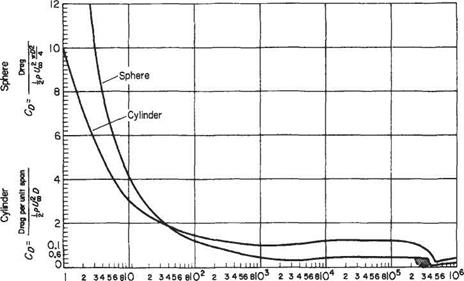Turbulence spheres
The effect of free-stream turbulence on the Reynolds number at which the critical drag decrease occurs was widely used many years ago to ascertain the turbulence level in the airstream of a wind-tunnel working section. In this application, a smooth sphere is mounted in the working section and its drag, for a range of tunnel speeds, is read off on the drag balance. The speed, and hence the Reynolds number, at which the drag suddenly decreases is recorded. Experiments in air of virtually zero small-scale
|
Re-^ Fig. 7.19 Approximate values of CD with Re for spheres and circular cylinders |
turbulence have indicated that the highest critical sphere Reynolds number attainable is 385 000. A turbulence factor, for the tunnel under test, is then defined as the ratio of 385 000 to the critical Reynolds number of the test tunnel.
A major difficulty in this application is the necessity for extreme accuracy in the manufacture of the sphere, as small variations from the true spherical shape can cause appreciable differences in the behaviour at the critical stage. As a result, this technique for turbulence measurement is not now in favour, and more recent methods, such as hot-wire anemometry, took its place some time ago.












